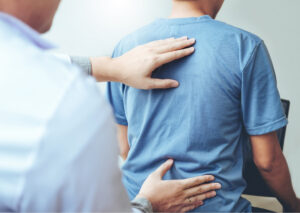The discs are protective shock-absorbing pads between the bones of the spine. Though they do not actually “slip,” a disc may split or rupture.Tears are always postero-lateral in nature, due to the occurrence of the posterior longitudinal ligament in the spinal canal. This tear in the disc ring, may result in the release of inflammatory chemical mediators, which may directly cause severe pain, even in the absence of nerve root compression. This condition is also known as a herniated, ruptured, prolapsed, or more commonly slipped disc.
Factors that lead to slipped disc include :
- Aging with associated degeneration and loss of elasticity of the discs and supporting structures.
- Poor posture combined with the usual use of incorrect body mechanics, hard physical labor (delivery), improper lifting, particularly if accompanied by twisting or turning; excessive strain, and sudden forceful trauma.
A herniation may develop suddenly or gradually over weeks or months.
People between the ages of 30 and 50 seem to be susceptible, as the elasticity and water content of the nucleus decreases with age. But, of late it has been seen that, even the people around the age group 20 – 30, are also getting affected with slip disc, because of their lifestyle, stress and diet habits.


